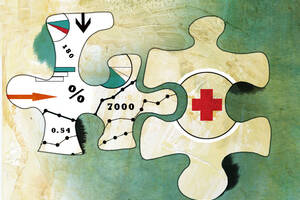It has long been said that no things in life are more certain than death and taxes. If anything could challenge these certainties, it might be the Internet – regarding taxes at least. While its technical capabilities and reach expand rapidly, the Internet leaves in its wake many complex, unresolved legal and economic issues. Kellogg’s Eric Anderson (Marketing), and colleagues Nathan Fong, Duncan Simester, and Catherine Tucker of the Sloan School explored one such issue when they studied the influence of state sales tax on e-commerce. Forthcoming in the Journal of Marketing Research, their work reveals how consumers and companies take advantage of the Internet’s information gathering powers and its privileged position on the taxation landscape when making household spending decisions and plotting corporate strategy.
“Though sales taxes could potentially have a profound impact on what people buy and from where they buy it, there have been few marketing studies on how sales tax and the Internet relate,” said Anderson.
Since West Virginia instituted the nation’s first statewide sales tax in the summer of 1921, all but five U.S. states have followed suit. While $100 worth of cell phones or bubble gum can still be bought for a tax free $100 in a few states like Delaware or Montana, it would cost $107 or more in states like Tennessee or Rhode Island. A 1992 ruling by the U.S. Supreme Court, however, ruled that a state could only force a seller to collect sales taxes if the seller had a physical presence in that state—such as a warehouse, office, or employees. In Quill Corporation v. North Dakota, the Court ruled that the state had violated the Commerce Clause of the U.S. Constitution and could not force Quill, a mail-order seller of office supplies, to tax sales in North Dakota because the company did not have a “nexus” in the state.
Lost Sales Tax Revenues
“The public policy debate is very interesting,” Anderson said. “There’s been legislation pending for the past few years to impose federal tax on all Internet purchases. As it currently stands, consumers are supposed to self-report their sales tax liabilities when making tax-free purchases online. But very few actually do this.”
The Direct Marketing Association estimates that $4 billion in sales taxes goes uncollected across the country each year.
To recoup an estimated annual $50 million of this unreported sales tax, the state of New York in early 2008 enacted a law to force many Internet retailers to collect taxes on sales in New York. E-commerce giants Amazon.com and Overstock.com have since sued the state, citing the Quill decision.
Comparing Store, Catalog, and Internet Sales
To bring some concrete evidence to bear upon such discussions of taxes and the Internet, Anderson and colleagues studied a company that sells moderately priced men’s and women’s clothing through retail stores, catalogs, and an Internet site. The company’s retail store expansion created an opportunity to study how customers respond when they are required to pay sales tax on catalog and Internet purchases. In 2002, the company opened its first store in a state that charged retail sales tax. Prior to the store opening, none of the customers in the state paid sales tax on catalog or Internet purchases from this company. But the store opening created a “nexus” that obligated the company to collect taxes on all orders in the state, whether at the store, via catalog, or from the Internet.
The team recognized that, in addition to the impact on sales tax, the store opening also had a “convenience” effect. Some consumers purchase through a store because they can try on clothing, pick up items immediately, and interact with a sales person. To focus on the tax effect and eliminate the convenience effect from their analysis, the team examined 13,000 customers who all lived more than one hundred miles from the new store.
“A two-hour drive is not particularly convenient, so virtually no customers visited the new retail store,” said Anderson. “But the new sales tax may have affected their behavior. That’s the question we wanted to investigate.”
“Consumers are supposed to self-report their sales tax liabilities when making tax-free purchases online. But very few actually do this.” The Direct Marketing Association estimates that $4 billion in sales taxes goes uncollected across the country each year.Anderson and colleagues recognized that their experiment needed a critical component: a control group to which they could compare the newly-taxed catalog and Internet shoppers. Said Anderson, “Consumer purchase behavior during this period was changing dramatically. The Internet was growing; catalog sales were declining. In such a dynamic environment, we needed something more than just to look at customer behavior before and after the store opening. That alone would not give us a good measure of the sales tax effect.”
To address this challenge, the team focused on customers who lived in closely-clustered counties on either side of the border with a neighboring state. Given this regional proximity, customers were likely to be similar in many important respects, such as their interest in Internet shopping and their desire and ability to buy new clothes. Customers in the neighboring state served as an ideal control group because they did not pay sales tax either before or after the store-opening.
“Tax effects are hard to document,” said Anderson. “Researchers typically look at border communities. For example, raise taxes in Illinois—then look at what happens across the border in Iowa. What is unique about our study is that we can examine the purchasing behavior of individual buyers.”
Having identified the customers, the team analyzed the influence of new taxes on purchases by comparing sales in the twelve months immediately before and after the opening of the new store. Internet purchases declined by 16 percent due to the sales tax. More surprisingly, sales through the catalog were unaffected.
“I expected to see a decrease in sales across the board, but I was wrong,” Anderson noted. “We were scratching our heads trying to figure out what was going on.”
The researchers hit a breakthrough when they looked at how demand changed for full-priced versus “sale” items. The team found that while sales tax had no impact on either Internet or catalog purchases of “sale” items, an interesting trend emerged for full-priced items: a large decrease in Internet purchases but no effect in catalog purchases.
“When we saw this, we knew we were starting to really understand what was going on,” said Anderson. Still, he added, a nagging question remained: “Why was the effect isolated to full priced items sold over the Internet?”
Internet Searchability is Key
The explanation came very quickly. When faced with sales tax, consumers’ demand is going to be affected by their incentive and ability to search for lower prices. “When an item is sold at a 30 percent discount, it is unlikely that you’ll get a better deal somewhere else. But if the item is full price you might quickly search the Internet and find a lower price,” said Anderson. “At the same time, a customer who is browsing a catalog from home may want to do the same type of search. But if they’re placing their order over the phone, it’s unlikely that they can easily search for a lower price.”
To support this theory, the authors looked at items that were sold at deeply discounted, moderately discounted, and full price. As expected, demand was extremely diminished for full priced items and slightly diminished for moderate discounts, but demand did not decrease for the deeply discounted items.
“Our results show that customers search in different ways. For example, I would have thought that sales would have dropped across the board. But it’s far more narrowly focused,” said Anderson. “There wasn’t any loss of demand through catalog shopping. For a consumer, it’s hard to realize you’re being taxed until the end of the call. But by then it&rsrsquo;s too late. If you want a blue shirt from the catalog, you may not have easy Internet access, so you can’t just go find a cheaper blue shirt. You’re on the phone, so you just complete the order.”
Lessons for Corporate Strategists
Turning their attention from consumer behavior to corporate strategy, Anderson and his colleagues then evaluated how state tax rates influence company decisions to open stores. They studied fourteen companies, each of which had fewer than two hundred stores, all within the continental United States. They found that catalog and Internet retailers tend to avoid opening stores in states with high tax rates. For a retailer who conducts 100 percent of its business via catalogs and the Internet, a 1 percent increase in a state’s sales tax rate decreases the probability that the company will open a store in that state by 4 percent.
“It’s tricky to sort out, depending on the relationship between the company’s offline presence and the state’s taxes, but companies systematically avoid high tax states,” said Anderson. “But then, once they open a store in one state, they can go ahead and open another, rather than open a store in a new state.”
Anderson could not say for sure how these findings might translate to other industries. “But we know that the fundamental aspects generalize,” he said. “Customers have the incentive to search if they find the prices to be too high, and they have the ability to search, via the Internet.”
Returning to the ongoing debate over tax policy, Anderson said, “What would happen with a federal Internet sales tax? The same principles we show would likely apply, because we wouldn’t expect fundamental consumer behavior to change. If the U.S. collects sales tax, then consumers might look to buy from Canada, or Bermuda—someplace that doesn’t collect the tax.”
Anderson, Eric T., Nathan M. Fong, Duncan I. Simester and Catherine E. Tucker (2010). “How Sales Taxes Affect Customer and Firm Behavior: The Role of Search on the Internet,” Journal of Marketing Research, April, 47(2): 1547-7193.


